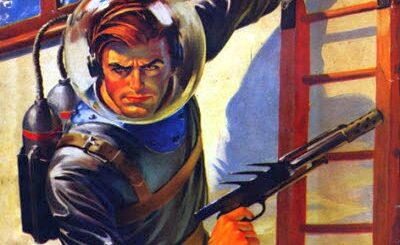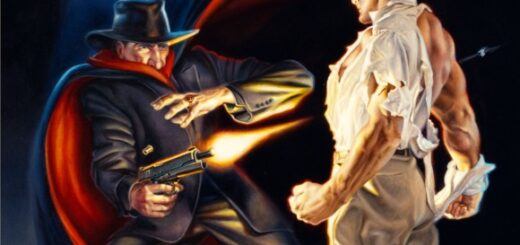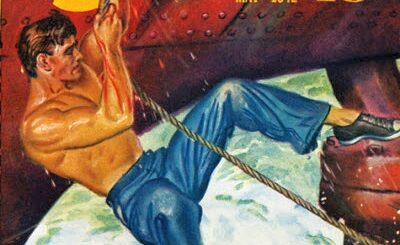Dust of Death
The tiny South American republics of Santa Amoza and Delezon were at war when a mysterious, hooded figure — known only as The Inca in Gray — appeared and began slaughtering citizens of both sides with a strange dust that brought instant, writhing death. Doc Savage and his mighty crew rush to the dense Amazonian forest in hopes of saving lives, but all they find when they arrive is a firing squad — ready to execute the Man of Bronze!






From an interview with Will Murray
When did you first start reading Doc Savage?
“January 1969. I just picked one up off a rack. It just appealed to me. It was called Dust of Death. It was the 32nd Bantam reprint and I read it and I was hooked.”
Well, I’m certainly not going to argue with Mr. Murray! I liked this story because of the emphasis on Long Tom and, of course, for the introduction of Chemistry into the Doc canon. Although, I have to admit that I only enjoyed the pet when they appeared as casual comic relief and not as integral plot elements.
“Dust of Death” starts off promisingly enough, but quickly becomes a muddled story. Although it has its moments, it ultimately emerges as a slight disappontment. Although the adventure has certain significance in the Doc Savage canon (for one thing, it is the escapade on which Ham aquires his pet Chemistry), the revelation of the identity of the Gray Inca gives rise to a major plot hole (if you’ve read the novel, you probably know what I mean). One of those Doc adventures which fell short of its potential.
Dust of Death is by no means a great Doc Savage tale, but it is remarkable in at least one aspect. Dust of Death introduces Ham’s pet Chemistry. I began rereading Dust of Death after The Majii because it is alluded too in the final pages as the next adventure. Note: There is an interesting behind-the-scenes story here about ghosts and Dent and editorial changes I believe, but that is best revealed by Will Murray.
Dust of Death is pretty straight forward: it is another “geopolitical” tale (just like The Majii) of third world manipulation into wars and unrest by unscrupulous warlords out for power and money. Therefore the villain is simply a crooked instigator using the hoodoo of some ancient myth to scare the locals and hide his true identity. Dust of Death is set in South America, in two neighboring countries Santa Amaoza and Delezon which seem to be on the border of Peru and Chile. Thus the villain creates the persona of the Inca in Gray, a shrouded mysterious person who kills by a gray poisonous dust sprinkled on his vitims. He has tricked the local native tribes into thinking he is a true Incan descendant (though there is a major problem with this I will mention in a moment) and manipulated the two nations into an extended, bitter four year border war.
Some nice moments concerning the aids: Long Tom is such a strong and violent fighter that in one ambush he picks up an attacker bodily and uses him as a club to take out six other men! Monk and Ham at one point (a good third of the last part of the book) are lost and/or captured out in the jungle and wage a long insult war. Ham wins, I suppose, because he discovers Chemistry and adopts him to anger Monk. In the end it turns out he is a sacred ape of the local Indian tribe and their priest gives him to Ham as a gift of thanks. Doc has some good Tarzan moments here in the trees and also has one of the toughest fights ever in his career against an unnamed “box” shaped thug whom he has to fight for a very very long time and suffers quite a lot of damage.
But some of the really interesting stuff involves his stratospheric dirigible, which is destroyed in this adventure. It has appeared or been mentioned elsewhere in the series (Mystery under the Sea, maybe), but here they take it down to South America and park it hovering over the capital Alcala. It is up in the stratosphere and they plane down from it. No one can see it or find it since it is in the upper atmosphere and there is a nice scene here where the sky above them is shown to be pitch black because it is the edge of space. Now this is probably the closest to space voyaging Doc ever gets and it is cool to read. To further this thought the dirigible also has rocket engines and can jet at over three hundred miles per hour it is said. Sad the strato-dirigible had to bite the dust in the desert. But at least it goes in a dramatic way in a kamikaze attack. Worth reading.
There is a truly strange and rather stupid moment in the very beginning of the book where villains cut the elevator cables to Doc’s private elevator. It falls 86 stories to the ground, but then bounces up safely, supposedly because it has natural air brakes, a sealed shaft that allows the air in the shaft to naturally be compressed into a cushion in case it falls. What? It refutes logic on a few fronts, including the fact that mere lines after the shaft is said to be made of bricks, which Doc uses to climb up. This structure could not sustain the pressure nor ever be hermetically sealed. Further, the killers had originally spied on Doc and gang from above because the elevator is just open steel grate and they can see down through it to them. Not only is this bizarre, but so is their behavior. The aids and Doc are all utterly cool as they fall, acting nonchalant and checking fingernails. Then after they survive Monk and Ham ask how they are alive and Doc has to explain it to them. Monk is then shown to be totally soaked in fearful sweat. ??? This is just a screwy scene that I think Dent would never have written.
This odd disconnection and unbelieveability is problematic throughout the book. There are many things that do not make sense or are just dropped (such as one scene when Monk and Ham are tied up in a sand pit and covered in honey and tortured by having ants from the jungle come swarm over them to devour them. It is going weell and they are being bitten, covered in ants, and thinking of the horror of their looming deaths. Then they are pulled out so they can be executed. Um? Also, there is a major problem with the Indian tribe in the jungle. They are said to be in the Andean jungles and follow the Inca in Gray because he is a descendant or reincarnation of their ancient ancestor and they want their own land returned, etc. Then, inexplicably they turn out to speak Mayan, so that Doc and the aids can talk to them in the crucial moments at the end and turn them against the crooks. Monk even uses the fact that Doc is an honored Son of kukulcan, the Feathered Serpent. This is all Mayan and Mesoamerican mythology. It has nothing to do with Incan and South American Indian culture. Chemistry is also said to be a sacred Mayan ape; this claim is repeated in later tales too, by the way, which is actually a very good theory if it had been real. it would have been great to connect Chemistry to Hidalgo and the sacred temples there. But all of this is mistaken, becasuse we are in South America on the Pacific coast near the Andes and dealing with descendants of the Incans. C’est la vie — but I don’t believe Dent would have made such a basic error. there must have been some ghosting/editorial snafus in this tale to have such glaring errors.
Anyway, this book is so-so and really only memorable because of the addition of Chemistry, the final character in Doc’s gang of amazing aids.
[c 2004 Thomas Fortenberry]
“Dust of Death” was good for a quick Doc fix, but as others have noted, there are way too many mistakes for the book to have been authored by Dent.
However, my major problem is stylistic. For the first three-quarters
of the book, the Inca in Gray is built up to be one of Doc’s most fascinating and dangerous foes. But his unmasking is clumsy, his motives are totally uninteresting and, of course, his actual identity is a snoozer. Dent never would have wasted such a good villain.
Oh well, the stratospheric blimp was fun.
Dust of Death is a good, quick read, but only if you have a bullet to bite. There are major plotting blunders and some pretty bad writing in places, and just lots of illogic. Yet, the “dust” itself is a great menace, one of Dent’s most clever . . . and I’ve always liked the Bama cover. (And I’ve NEVER liked Chemistry. Whenever he appears in Doc adventures I just pretend he isn’t there. Chemistry was always a bad idea. Habeas I can tolerate; it’s a wonderful trope to pester Ham with. But I have no idea why the editors at Street and Smith let Chemistry into Doc’s adventures.
This was a huge disappointment. The best thing about it is Bama’s cover painting (one of the artist’s favorites).
The other postings elaborate on the plot holes. This turkey has been attributed to Harold Davis, with a rewrite by Dent. (Unfortunately, Dr. Dent could not save the patient).
I agree, a lot of great ideas were squandered in this one.
Sorry, guys, but I MUST disagree! This is one of the best Docs I have ever read! The scene on the dirigible where Doc encounters the squat, box-shaped man has to be one of the most suspenseful that Robeson ever penned. Unlike other occasions when Doc went one-on-one with a bad lad, I actually had the impression that the bronze man COULD come off second-best. The unmasking of The Inca In Gray may have been less than well-handled, but the identity of the head hombre was still a surprise. At least give it a try. Four and a half stars from me! And, oh yes, the Bama cover is awesome!
Read this as a pre-teen in the 1970s. And I loved it. Think CHACO WAR. Bolivia versus Paraguay 1932-35. A brutal war in a desert that killed upwards of 100,000, so many due to dehydration. This was published in 1935. The war ended in June but was still tense then during the peace talks that took 3 years to resolve the issues.